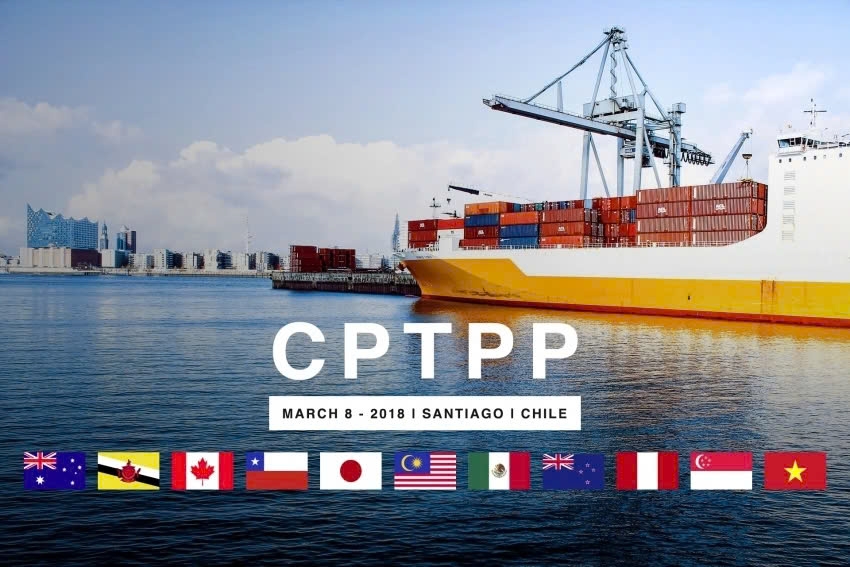Six years of CPTPP enforcement: Opportunities for Vietnamese exports
VOV.VN - The past six years of implementation has seen the Comprehensive and Progressive Agreement for Trans-Pacific Partnership (CPTPP) recognised as one of the agreements delivering significant benefits for Vietnamese exports to many lucrative markets.

The CPTPP has been joined by 12 countries worldwide, including the UK’s accession last year, opening up new opportunities and challenges for Vietnam, particularly as the 12-member trade bloc represents 15% of global GDP and large markets of more than 500 million consumers.
Great benefits
The trade deal initially came into effect for Vietnam on January 14, 2019. Although data on Vietnamese import-export activities with CPTPP markets in 2024 is not yet available, specific industries and export items have shown remarkable growth annually. Many products now benefit from high utilisation rates of CPTPP preferential Certificates of Origin (C/O).
Most notably, Vietnamese enterprises in particular have effectively leveraged CPTPP benefits in markets in the Americas, such as Canada, Mexico, and Peru, all of which established trade agreement relationships with Vietnam for the first time through the CPTPP. More than five years of CPTPP implementation has seen Vietnamese trade turnover with these markets increase by more than 56%, according to the Ministry of Industry and Trade.
“Since the agreement came into force, key Vietnamese exports like electronics, seafood, and wooden products have gradually gained a foothold in CPTPP markets,” said Vo Thi Hong Anh, deputy director of the European and American Market Department under the Ministry of Industry and Trade.
Anh cited statistics highlighting that Vietnam currently supplies about 35% of shrimp consumed in Canada. Similarly, Mexico is one of the top three export markets for Vietnamese pangasius.
From a business perspective, Le Hang, communications director of the Vietnam Association of Seafood Exporters and Producers (VASEP), and Nguyen Thi Huong, director of Gold Cashew Co., Ltd., noted that nearly six years of exporting under the CPTPP framework has significantly boosted market shares.
“The market share of Vietnamese seafood in these countries has increased, demonstrating the competitive strength of our products supported by the CPTPP. For instance, in Canada, Vietnam’s market share has risen from 7-8% to 10%, with shrimp specifically increasing from 18% to 25%. In Australia, Vietnamese shrimp dominates 70% of the market, doubling its share from 32% before the CPTPP,” said Hang.
In her opinions, agricultural products, textiles, footwear, and other industrial exports have also taken advantage of CPTPP benefits, thereby increasing exports whilst building up the reputation of Vietnamese goods in these markets.
Room for improvement
Despite recording impressive gains, many Vietnamese products are still exported as raw materials in small quantities to CPTPP markets. Vietnamese Trade Counselor in Malaysia Le Phu Cuong pointed out that Vietnamese agricultural exports to Malaysia, like rice and coffee, have enjoyed significant growth, but they are mostly raw products.
With a combined population of about 500 million, the CPTPP markets hold vast export potential for the country. Ngo Chung Khanh, deputy director of the Multilateral Trade Policy Department, remarked that opportunities to penetrate deeper into CPTPP markets, especially those in the Americas, remain abundant. Some products currently account for only 3 - 5% of market share, while CPTPP-certified goods represent just 5% of total export turnover to these markets.
The UK’s accession to the CPTPP in December 2024 creates further opportunities for Vietnamese goods, especially seafood, due to additional market access commitments beyond existing bilateral FTAs.
Currently, six more economies, including China, Taiwan (China), Costa Rica, Ecuador, Uruguay, and Ukraine, have expressed an interest in joining the CPTPP.
“The inclusion of major economies like China and Taiwan reflects the increasing importance of the CPTPP, which will undoubtedly create new dynamics for businesses and investors, especially in Vietnam,” emphasised the official.
Prime requirements
The CPTPP expands market opportunities whilst imposing high standards as a next-generation free trade agreement. Vietnamese businesses must therefore make continuous efforts to meet these market requirements if they want to gain a firm foothold in these markets.
According to Vu Duc Giang, chairman of the Vietnam Textile and Apparel Association, the CPTPP is a transformative force driving innovation and global integration for the Vietnamese economy, particularly in textiles. It opens doors to new markets like Canada, Australia, and New Zealand, and at the same time helps businesses to adapt to procurement methods within this economic bloc.
The CPTPP also requires firms to focus on origin certification and sustainable production practices. Greening production is not only a requirement for CPTPP markets, but is also a global standard for Vietnamese exports to meet.


